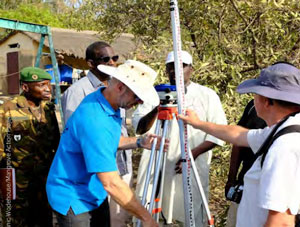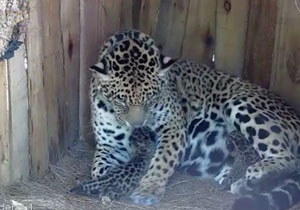|
The MAP News
445th Edition June 23, 2018 |
|
FEATURE Children promote the importance of mangroves
MEXICO - In order to draw attention to the importance of mangroves in Sisal, due to its great ecological wealth, in recent days the painting contest "The importance of mangrove forests in my community" was held, whose winners will participate in a contest in the United States. "Through this contest we seek to raise awareness that we must avoid contamination of the mangroves with garbage, sewage, etc., and also prevent them from being cut down and destroyed," said Luis Maldonado López, of Cinvestav, one of the organizers. Prior to the contest, a workshop on garbage and the studies they do with drone assistance was given in schools in the port. Emphasis was placed on the environmental services provided by the mangrove forest to the community. The local contest served to select those who are now participating in the international event in the USA. The works that are awarded in the international competition, said López, will be published in a calendar that will be printed by the environmental organization Mangrove Action Project (MAP). READ MORE AFRICA CBEMR : re-establishing a more biodiverse and resilient coastal ecosystem with community participation  WEST AFRICA - Seeking the most effective path towards long-term mangrove conservation and recovery, Mangrove Action Project (MAP) promotes the concept and practice of Community-based Ecological Mangrove Restoration (CBEMR). This holistic approach to mangrove restoration views the proposed plant and animal communities to be restored as part of a larger ecosystem, connected with other ecological communities that also have functions to be protected or restored. Mangrove forests can self-repair, or successfully undergo secondary succession, if the normal tidal hydrology is restored and if there is a ready source of mangrove seedlings or propagules from nearby stands that are accessible to reseed an area. CBEMR focuses on re-establishing the hydrology, which will facilitate this natural regeneration process. CBEMR also engages local communities in the restoration process, empowering them to be stewards of their environment, and enabling them to regain the livelihoods ruined when the mangroves were destroyed. MAP is planning CBEMR training workshops in both East and West Africa, working with field-based NGOs such as Wetlands International Africa in Senegal and Guinea Bissau. READ MORE Creating a forest landscape restoration movement in Africa: a call to heal planet Earth GHANA - This edition of Nature & Faune journal explores the science and innovations (technical, social and policy) that can support the achievement of the African dream of restoring 100 million hectares of its degraded land. Articles in this edition share experiences on challenges, opportunities and successful restoration, including farmer managed natural regeneration, improved management of smallholder woodlots, reforestation, evergreen agriculture with intercropped trees, and associated sustainable land management practices such as water harvesting and erosion control. Africa’s Great Green Wall is presented in this edition as a transformative model for rural communities’ sustainable development. In particular the lessons learned from the “Action Against Desertification” programme funded by the European Union and implemented by FAO with partner countries and organizations, are discussed, paving a way towards the implementation of African Forest Landscape Restoration Initiative. READ MORE ASIA MAP-Thailand hosts field study trip from Gudandong Ocean University, China  THAILAND - In May of 2018, Mangrove Action Project (MAP) Thailand had the opportunity to host a week-long study tour on coastal management for four professors from the Agricultural College at Gudandong Ocean University, Zhanjiang City, Guandong Province, China. We were also very pleased to be joined by Leo Thom, MAP’s Creative Director who is based in the UK. The focus of the trip was on MAP’s Community Based Ecological Restoration (CBEMR) sites on the Andaman coast of southern Thailand an area which was hit by Indian Ocean Tsunami of 26 December 2014. The field study trip took place in many Community Based Ecological Mangrove Restoration (CBEMR) sites such as Bang Khang Khao in Trang province, Klong Lu, Koh Klang and Nai Nang site as well as the Nai Nang Apiculture group in Krabi province. READ MORE Eco Village: An adaptation strategy to conserve Mangroves Ecosystem  Bangladesh Environment and Development Society and Korea Green Foundation have taken a grass-roots initiative to build an Eco Village in Banishanta Union of Dacope Upazila under Khulna district in Bangladesh since 2015. The Eco village project is divided into three components: the Green Housing, Green Education, and Green Business. All aim at increasing use of sustainable energy while conserving the mangrove ecosystem. The Sundarbans coastal region is a disaster prone area and it forms the front line of Global Climate Change; therefore, the coastal people lose their source of drinking water, crops, livestock and farming land due to the negative impact of climate change. READ MORE Mangrove Pneumatophores: Oases Of Biodiversity In Mangrove Mud  INDIA - Scientists are always fascinated by the various kinds of adaptations that mangroves possess to survive in coastal areas. Mangroves are salt-tolerant plants growing in tropical and subtropical coastlines. Although these plants constitute only 0.5% of the world’s coastal area, they provide billions of dollars in terms of ecosystem services such as fisheries, nutrient cycling, and carbon storage. If you visit any mangrove ecosystem represented by Avicennia or Sonneratia species, you will be surprised to see that these plants possess unique roots called pneumatophores. Unlike the roots of other marine and terrestrial plants, these pneumatophores emerge from the muddy sediments of the mangrove floor and grow in an upward direction. The pneumatophores possess minute pores called lenticels on their surface for the intake of oxygen from the atmosphere, and which carry out respiration. Although these functions of pneumatophores have been known for a long time, our study evaluated the pneumatophores of Avicennia officinalis (L.) collected from Goa (central west coast of India). It was found that these roots are home to diverse species of microalgae and meiofauna (metazoan invertebrates and foraminifera in the size range 63-500 µm). READ MORE 50,000 tonnes plastic in mangroves of Mumbai  INDIA - Mangrove forests in the Mumbai Metropolitan Region (MMR) are littered with at least 50,000 tonnes of plastic waste. Since the beginning of this year alone, the mangrove cell of the state forest department has removed more than 9,000 tonnes of trash, mostly plastic waste, from nine mangrove sites. “Acting as the interface between land and sea, the mangrove ecosystem is the first natural resource exposed to maximum plastic coming from creeks, rivers and the sea,” said N Vasudevan, additional principal chief conservator of forest, state mangrove cell. “While assessing the quantum of trash from 14 locations across Mumbai, we found that a minimum of 3,500 tonnes of plastic waste is strewn at these areas at any given point in time. It means approximately 50,000 tonnes across all mangrove patches in Mumbai.” READ MORE Tiger turf wars in Bangladesh's Sundarbans  BANGLADESH - The Sundarban mangrove forest in western Bangladesh is one of the last havens for the endangered Bengal tiger. With only 100 tigers thought to be remaining in the area, every individual tiger's survival counts. But the tigers aren't the only ones that live there. They share the forest and its resources with over a million people in the surrounding villages - a human population that has doubled in size in the last 40 years. And the locals' relationship with the tigers has been hostile at best. The tigers kill or maim villagers and in retaliation the villagers hunt the tigers, causing a vicious cycle. "We have 106, with the historical data about two to three tigers killed by the local villagers every year. But 30 to 50 humans are killed every year," says conservationist Mahbub Alam. READ MORE AMERICAS Groups March in Washington, DC During Ocean Week To Oppose Offshore Fish Farms USA - hundreds of people joined together in a March for the Oceans in Washington, DC. Preventing development of industrial ocean fish farms is a prominent issue for participants, wearing pins and carrying signs with the hashtag "#dontcageouroceans". Alfredo Quarto of the Mangrove Action Project said, "MAP has advocated for over two decades against open water industrial fish feedlots globally. We strongly urge Congress not to consider these kinds of wasteful and unsustainable systems in the U.S." Worldwide, ocean finfish aquaculture has caused a wide range of problems, including fish escapes; deaths of sharks, seals and other marine life; and changes in ocean ecosystems. Marianne Cufone, Executive Director for the Recirculating Farms Coalition said, "Industrial open water finfish farming is an outdated and unnecessary practice. It poses serious risks to our oceans and public health." Over 100 other organizations agree, and signed a letter earlier in the week to members of Congress, calling on legislators to protect oceans from development of marine finfish aquaculture off U.S. shores. READ MORE Scientists find surprising genetic differences between Brazil’s mangroves  BRAZIL - Hugging tropical coastlines with masses of long, tangled branches and roots that stick up out of the mud at low tide, mangrove forests all have a similar look at first glance. But dig a little deeper into their genes and surprising differences pop up. When researchers from institutions in Brazil did just that, they discovered that mangrove trees along the same coastline and of the same species were genetically distinct from each other. They think these differences likely arose because oceanic currents act as a barrier to mangrove tree seeds, effectively separating the two populations. In addition to genetic differences, some mangroves have physiological adaptations that make them better suited to their specific environments. The researchers say their results, published in the journal Ecology and Evolution earlier this year, highlight the importance of enacting conservation plans that give a higher priority to the preservation of genetic diversity – an endeavor they say is becoming more and more critical for mangroves as they continue to disappear. READ MORE Global mangrove soil carbon map aids conservation  Mangrove forests are among the most carbon-dense ecosystems in the world and valuable sinks for carbon emissions released into the atmosphere. Now a global map of soil carbon in mangrove forests at 30 m spatial resolution could support new ecosystem services policy tools for rewarding the preservation of major environmental assets. “We felt that working at 30 m resolution was critical because of the strong gradients that occur in mangrove forests across the tidal range,” says Jonathan Sanderman of Woods Hole Research Center in the US. “Within a few hundred metres, there can often be a two-fold variation in soil carbon stocks and we wanted to be able to capture this important local variance in soil carbon.” Sanderman and colleagues developed a machine-learning based data-driven statistical model of the distribution of carbon density at key sites around the world. READ MORE First Jaguars Born in This Argentinian Wetland in Over a Century  ARGENTINA - Two jaguars were born in northeastern Argentina’s Iberá National Park, one of the largest freshwater wetland systems in the Americas. The cubs are currently unnamed and unsexed, but researchers are excited about what kind of conservation implications these births have for the near-threatened species. “They have passed the most critical days and they seem to be healthy and suckling well from their mother,” Ignacio Jiménez Pérez, a National Geographic grantee and conservation coordinator at the Conservation Land Trust Argentina, writes in an email. Although they’ve filmed the cubs, the scientists have not accessed their pen yet because they want to be as noninvasive as possible. They will wait several more days before moving Tania to another pen so that they can briefly access the cubs, Pérez says. READ MORE OCEANA Methane emissions partially offset “blue carbon” burial in mangroves AUSTRALIA - The preservation and enhancement of natural carbon stores are part of global climate change mitigation strategies. Despite offering valuable ecosystem services to the coastal zone and its inhabitants, coastal vegetated ecosystems also stand out as large natural carbon stores. The term “blue carbon” was coined to describe the carbon captured in coastal habitats such as mangrove forests, seagrass beds, and salt marshes. Mangrove forests, in particular, are highly productive ecosystems with global carbon sequestration rates that are disproportionate to their area. However, here, we show that CH4 emissions from mangrove waters have the potential to offset blue carbon burial rates in sediments on average by 20% (sensitivity analysis offset range, 18 to 22%). Hence, CH4 emissions from mangroves need to be accounted for when assessing their importance in climate change mitigation. READ MORE |
WANT TO GET INVOLVED?
|
Mangrove Action ProjectClick here to view past newsletters |
|
Mangrove Action Project's mission is to empower communities worldwide to restore, manage, and conserve mangrove forests. Through science, training, and environmental education, we provide nature-based solutions for people and our planet. MAP newsletter brings you news you can use: stories from around the globe pertaining to mangroves and the people who rely on them. To search a database of all MAP blogposts over the past 30 years, enter text in the box below. Thank you for loving the mangroves!










No comments:
Post a Comment
Note: Only a member of this blog may post a comment.